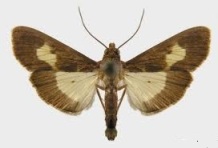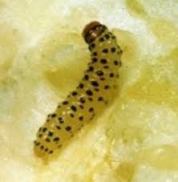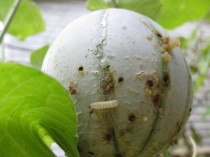You are currently browsing the tag archive for the ‘pickleworms control’ tag.
Common name: Pickleworm
Scientific name: Diaphanis nitidalis
Distribution
Pickleworms are tropical insects and cannot tolerate cold temperatures. These pests are predominant in the southeastern United States, ranging as far north as Connecticut, Illinois, Iowa, Kansas and New York. They overwinter in Florida and Texas, where they may be active year round. They are known to spread northward late in the season.
Lifecycle and Description
Adults: The pickleworm adult moth is a small flashy moth with wide triangular wings and a wingspan of 1 ¼ inches. The wings are mostly iridescent brown with a central band of semi-transparent yellow. The tip of the abdomen contains a cluster of brush-like hairs. Pickleworm moths are generally inactive during the day and peak flight activity occurs typically 3-5 hours after sundown.
Eggs: Adult moths lay tiny eggs directly on growing areas of the plant, such as new leaf buds, flowers and shoots. Eggs are white initially, but change to yellow as they mature. Eggs hatch in about 4 days.
Larvae: The young larvae of pickleworms are thin white caterpillars with numerous black spots. As they mature though, they get plump and darker in color while losing their spots. Color is dependant largely on the insect’s food source. When mature, larvae often attain a length of 1 inch. Pickleworms undergo 5 larval instars before pupating.
Pupae: Pupation usually occurs in a leaf fold, and dead, dry leaf material is used. Pupae are brown and about ½ inch long.
A pickleworm can complete its life cycle in 30 days and there can be up to 4 generations a year.
Host plants
Pickleworms feed on both wild and cultivated cucurbit species. Creeping cucumber, Melothria pendula, is an important wild host. Cucumber, pumpkin, muskmelon, cantaloupe and squash are the common hosts of pickleworms. Among all cucurbits, summer squash is the most preferred, and the most heavily damaged.
Damage
Primary concern with pickleworms is damage to the fruit. Pickleworm larvae do however, feed on, and tunnel into, flowers, vines and fruit. Young pickleworms usually feed for some time among small leaves at the growing tips of vines or within blossoms. Growing vines can get riddled with holes and cease to grow. As pickleworms grow they bore into fruit and continue to feed, causing internal damage to fruit. Entry holes are marked with a pile of white frass. Damaged fruit usually sours, spoils and rots.
Organic Control and Prevention of Pickleworms
1. Early planting: Early-planting enables growers to harvest most of the crop before the pickleworm can cause excessive losses. Very early spring plantings are seldom damaged.
2. Trap crop: Squash could be used as a trap crop to keep pickleworm from attacking other cucurbits, as squash is the preferred host of pickleworms.
3. Screen covers: The use of floating row covers has been shown to be effective against pickleworm moths and other insects from laying eggs on the plants. Row covers should be applied immediately after planting; however, they must be removed when plants begin to flower to allow for pollination.
4. Sanitation and weed control: Removal and destruction of infested plants including vines and fruit following harvest is a good cultural practice to reduce populations. Keeping the surroundings clean and weed-free can go a long way in preventing pickleworms from overwintering in and around your garden.
5. Fruit bagging: An experiment carried out in the field to test the efficacy of paper bags for protecting cucumber fruits against pickleworm penetration showed that paper bagging is 50% more effective than conventional insecticide! In addition, the color and size of the fruit were not altered by bagging.
6. Use of resistant varieties: The following varieties have demonstrated marked resistance to pickleworms: Butternut 23, Summer Crookneck, Early Prolific Straightneck and Early Yellow Summer Crookneck. Beware; the following varieties are more susceptible to pickleworms: Cozini, Zucchini, Black Zucchini Caserta, Shrot Cofozella and Benning Green Tint Scallop.
7. Monitor and handpick: Scout regularly for eggs among your cucurbits. Infested stems can be slit horizontally and the pickleworms can be removed. Soil should be placed over the injured stem to encourage rooting.
8. Natural predators: Pickleworms have natural enemies such as the soldier beetle, Calosoma beetles, Harpalus beetles, red imported fire ant, trichogramma wasps and braconid wasps that can help control or prevent infestations to an extent.
9. Spraying Bt (Bacillus thuringiensis) or Steinernema carpocapsae, a beneficial nematodes is a great solution according to a vegetable crop specialist at the University of Florida. To control an infestation, spray Bt or beneficial nematodes in the early evening on susceptible plants.
10. Neem and Spinosad: Neem products are botanical insecticides that are effective against a variety of insect pests including pickleworms through contact toxicity, disruption of insect molting and feeding deterrence. Spinosad is derived by microbial fermentation and is effective against pickleworms while being safe to most beneficial insects.
Buy Grub Control, a unique organic formulation that can be used as preventative or early treatment against young active larvae. In need of some horticultural oil for organic insect and disease protection? Neem oil may just be the what you need.



